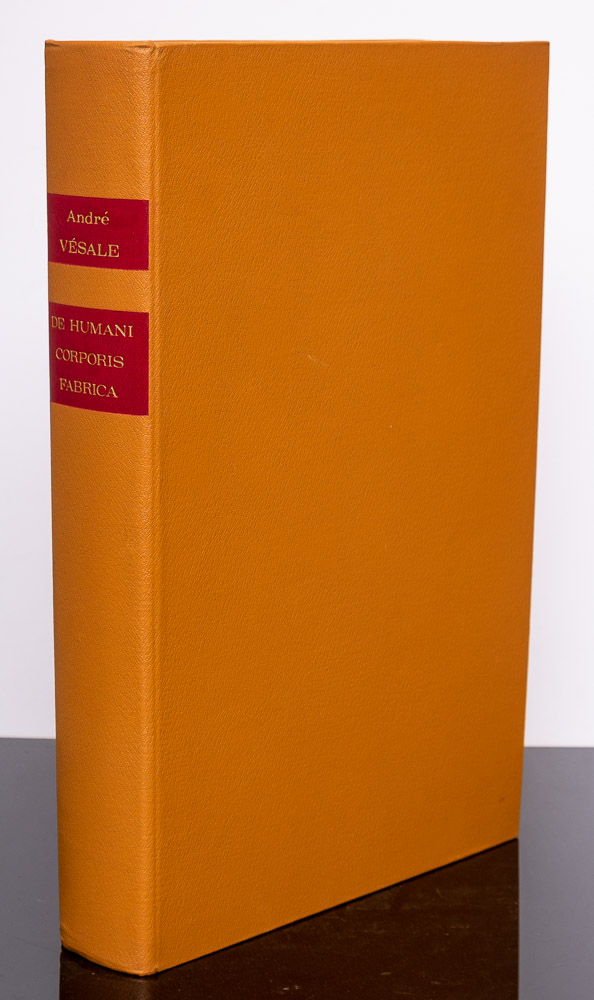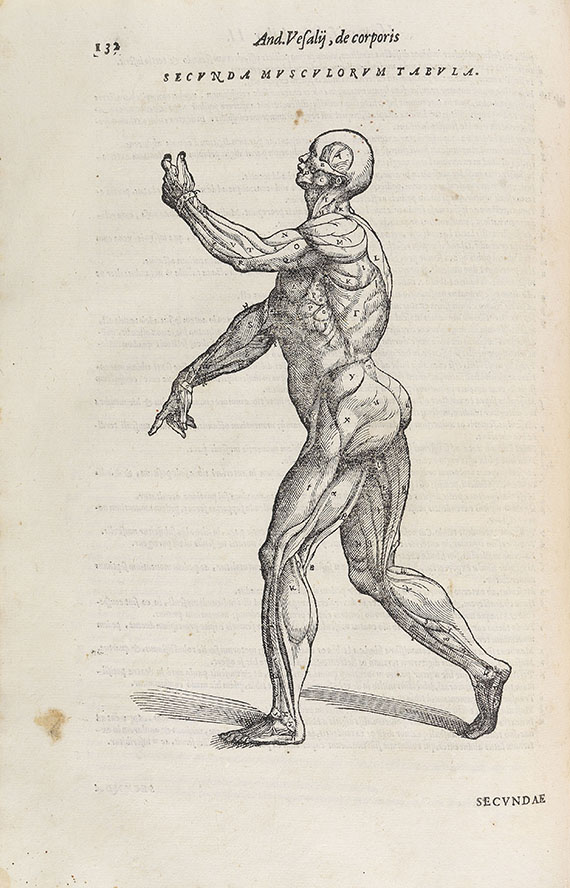VESALIUS, Andreas (1514-64). De humani corporis fabrica, lib. VII . Lyons: Jean de Tournes 1552. 2 volumes, 16 o (118 x 72 mm. [v.2: 120 x 74mm], binding size: 123 x 81 mm. [v. 2: 127 x 80 mm]). Collation: Vol. I: a-z A-I 8 aa-zz 2A-M 8 N 4; Vol. II: a-z A-Z aa-ll 8. 540; 456 leaves (ll8 in vol. II blank). Italic type, shoulder notes in roman. Four small woodcuts of the cranium on i1v and i2r-v, printer's devices on titles (Cartier "Vipres o.") and on versos of last leaf in vol. I and penultimate leaf in vol. II (Cartier "Prisme d"), six-line woodcut arabesque initials, matching woodcut head-pieces. Error on printer's note on I:a1v corrected in ink (by the printers?). Ruled in red throughout. (Lower fore-corner of vol. I title a trifle frayed, short closed marginal tear to II:z8, occasional very small light inkstains from the red ruling). Binding : Bound circa 1594-1597 for Pietro Duodo by the Parisian "Atelier de la seconde palmette" in gold-tooled citron morocco, covers with an outer border of leafy sprays surrounding central panel containing 14 oval and 4 small circular laurel-branch medallions, each of the ovals decorated with one of six different floral tools, smaller flower tools in the interstices, at center a larger oval medallion containing on the upper covers Duodo's arms of three fleurs-de-lys in a bend, and on the lower covers Duodo's device "Expectata non eludet" over a triple-flowered lily, flat spines similarly gilt with four flower medallions, title and volume number tooled in central medallion, gilt edges, each volume with a pair of 4 paper endleaves including pastedowns, watermark Briquet 9273 discernible on lower free endpaper in vol. II (light wear to joints and extremities); modern cloth folding cases. Provenance : PIETRO DUODO (1554-1611), Venetian ambassador to the Court of Henri IV from 1594-1597, supra-libros as above; 19th-century shelfmark or lot label on front free endpaper of vol. I, "365/2"; "991" in ink on front pastedown of vol. II. Second edition. This unauthorized pocket-sized edition, which closely follows the text of the 1543 edition but reproduces only four of the woodcuts, was one of a series of small format editions of texts of proven success produced by Jean de Tournes I from the mid-1540s through the 1560s. During the previous decade Lyons had become a center for the publication of pocket editions of the medical classics, usually translated into French. The printer's note on the verso of the first title explains that the edition was printed for the use of students, but clearly, "Jean de Tournes' venture could scarcely have been a profitable one, for the Fabrica without [its] illustrations was not the same book by any means" (Cushing). Cushing noted that copies with both volumes in matching bindings are rare. The present copy, one of about 100 small-format editions purchased by Pietro Duodo during his ambassadorship in Paris, whose nearly uniform bindings he commissioned from a single Parisian atelier, is undoubtedly the finest copy extant of the 1552 Vesalius. From their first appearance on the market at the end of the 18th century, these exquisite little red-ruled books with their semis of floral medallions were attributed to the library of Marguerite de Valois, aparently on no other grounds than the daisies that liberally decorate their covers. In 1925 Ludovic Bouland identified the true owner as the Venetian diplomat Pietro Duodo, but the attribution to a specific bindery remained speculative, the execution of the bindings being generally ascribed to the catch-all shop of Clovis Eve The use of the same set of tools on all of the bindings bearing Duodo's arms and device, as well as the uniformity of their sewing structure, show that Duodo commissioned all of his bindings from the same atelier, very likely all at once or in two or three large batches. For example, nearly all of Duodo's bindings contain an identical system of enlacement, the ends of the sewing bands forming a "
VESALIUS, Andreas (1514-64). De humani corporis fabrica, lib. VII . Lyons: Jean de Tournes 1552. 2 volumes, 16 o (118 x 72 mm. [v.2: 120 x 74mm], binding size: 123 x 81 mm. [v. 2: 127 x 80 mm]). Collation: Vol. I: a-z A-I 8 aa-zz 2A-M 8 N 4; Vol. II: a-z A-Z aa-ll 8. 540; 456 leaves (ll8 in vol. II blank). Italic type, shoulder notes in roman. Four small woodcuts of the cranium on i1v and i2r-v, printer's devices on titles (Cartier "Vipres o.") and on versos of last leaf in vol. I and penultimate leaf in vol. II (Cartier "Prisme d"), six-line woodcut arabesque initials, matching woodcut head-pieces. Error on printer's note on I:a1v corrected in ink (by the printers?). Ruled in red throughout. (Lower fore-corner of vol. I title a trifle frayed, short closed marginal tear to II:z8, occasional very small light inkstains from the red ruling). Binding : Bound circa 1594-1597 for Pietro Duodo by the Parisian "Atelier de la seconde palmette" in gold-tooled citron morocco, covers with an outer border of leafy sprays surrounding central panel containing 14 oval and 4 small circular laurel-branch medallions, each of the ovals decorated with one of six different floral tools, smaller flower tools in the interstices, at center a larger oval medallion containing on the upper covers Duodo's arms of three fleurs-de-lys in a bend, and on the lower covers Duodo's device "Expectata non eludet" over a triple-flowered lily, flat spines similarly gilt with four flower medallions, title and volume number tooled in central medallion, gilt edges, each volume with a pair of 4 paper endleaves including pastedowns, watermark Briquet 9273 discernible on lower free endpaper in vol. II (light wear to joints and extremities); modern cloth folding cases. Provenance : PIETRO DUODO (1554-1611), Venetian ambassador to the Court of Henri IV from 1594-1597, supra-libros as above; 19th-century shelfmark or lot label on front free endpaper of vol. I, "365/2"; "991" in ink on front pastedown of vol. II. Second edition. This unauthorized pocket-sized edition, which closely follows the text of the 1543 edition but reproduces only four of the woodcuts, was one of a series of small format editions of texts of proven success produced by Jean de Tournes I from the mid-1540s through the 1560s. During the previous decade Lyons had become a center for the publication of pocket editions of the medical classics, usually translated into French. The printer's note on the verso of the first title explains that the edition was printed for the use of students, but clearly, "Jean de Tournes' venture could scarcely have been a profitable one, for the Fabrica without [its] illustrations was not the same book by any means" (Cushing). Cushing noted that copies with both volumes in matching bindings are rare. The present copy, one of about 100 small-format editions purchased by Pietro Duodo during his ambassadorship in Paris, whose nearly uniform bindings he commissioned from a single Parisian atelier, is undoubtedly the finest copy extant of the 1552 Vesalius. From their first appearance on the market at the end of the 18th century, these exquisite little red-ruled books with their semis of floral medallions were attributed to the library of Marguerite de Valois, aparently on no other grounds than the daisies that liberally decorate their covers. In 1925 Ludovic Bouland identified the true owner as the Venetian diplomat Pietro Duodo, but the attribution to a specific bindery remained speculative, the execution of the bindings being generally ascribed to the catch-all shop of Clovis Eve The use of the same set of tools on all of the bindings bearing Duodo's arms and device, as well as the uniformity of their sewing structure, show that Duodo commissioned all of his bindings from the same atelier, very likely all at once or in two or three large batches. For example, nearly all of Duodo's bindings contain an identical system of enlacement, the ends of the sewing bands forming a "















Try LotSearch and its premium features for 7 days - without any costs!
Be notified automatically about new items in upcoming auctions.
Create an alert